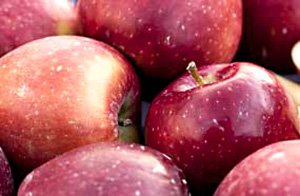 Washington State apple producers expect to harvest 120 million packed boxes of apples this fall, according to the industry’s August forecast, the first official tally of the season.
Washington State apple producers expect to harvest 120 million packed boxes of apples this fall, according to the industry’s August forecast, the first official tally of the season.
That’s a drop of 9 million boxes from last year. However, Michigan and New York production has rebounded from 2012 when cold spring weather decimated the crops. Together, the two states are likely to ship around 30 million more boxes of fresh apples than last season.
Last year, Washington’s production jumped by about 20 million boxes. Dan Kelly, assistant manager at the Washington Growers Clearing House Association, said that typically when there’s a big increase in production, the market doesn’t adjust until the following year. “But in this case, when we jumped last year, we had a record crop and record prices,” he said.
Even with the Midwestern and New York crops being larger this season, Washington’s 120-million-box crop seems manageable, Kelly said.
The total 2013 U.S. fresh apple crop is estimated at about 245 million boxes, which would be only the third largest national crop since 2000, he calculates. The record volume was 252 million boxes in 2000, followed by 249 million in 2004.
In Washington, most varieties are down from last year with the exception of Gala (which increased 1 percent), Granny Smith (up 9 percent), and Honeycrisp (up 13 percent).
The Red Delicious crop is forecast at 33.7 million boxes, Gala at 26.3 million, Fuji at 15.6 million, Granny Smith at 15.0 million, and Honeycrisp at 5.7 million.
Washington’s organic apple production is estimated at 7.6 million boxes, down from 8.3 million last year.
Todd Fryhover, president of the Washington Apple Commission, said the 120-million-box estimate was not unexpected. What’s important, more than the total number, is the break-down by variety, he said. The estimate shows that Red Delicious, Golden Delicious, and Fuji are all down while Granny Smith, Gala, Honeycrisp, and newer varieties are up, which is a positive sign.
However, as greater volumes of newer varieties move onto the domestic market, more of the traditional varieties might need to be exported.
Overall, exports of Washington apples during the 2012-13 season are 9 percent up from the previous season, even though exports to Asia were hampered by trade issues in China and Indonesia and a currency devaluation in India. Mexico and Canada, the top two export markets, both took almost a third more apples than the previous year and, by the end of the season, Washington’s exports could hit the 40-million-box mark.
“This year’s been good all the way round, domestic and export,” Fryhover said. “It’s been spectacular.”

Leave A Comment